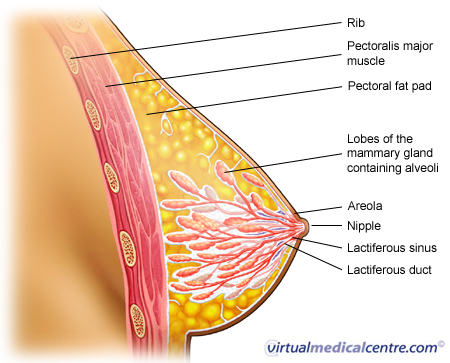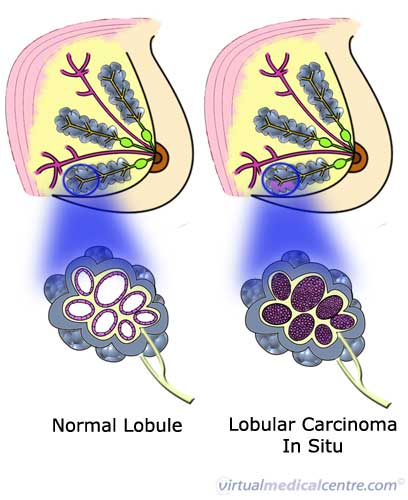- What is Pre-Invasive Lobular Carcinoma (Lobular Carcinoma In Situ; LCIS; Breast Cancer)
- Statistics on Pre-Invasive Lobular Carcinoma (Lobular Carcinoma In Situ; LCIS; Breast Cancer)
- Risk Factors for Pre-Invasive Lobular Carcinoma (Lobular Carcinoma In Situ; LCIS; Breast Cancer)
- Progression of Pre-Invasive Lobular Carcinoma (Lobular Carcinoma In Situ; LCIS; Breast Cancer)
- Symptoms of Pre-Invasive Lobular Carcinoma (Lobular Carcinoma In Situ; LCIS; Breast Cancer)
- Clinical Examination of Pre-Invasive Lobular Carcinoma (Lobular Carcinoma In Situ; LCIS; Breast Cancer)
- How is Pre-Invasive Lobular Carcinoma (Lobular Carcinoma In Situ; LCIS; Breast Cancer) Diagnosed?
- Prognosis of Pre-Invasive Lobular Carcinoma (Lobular Carcinoma In Situ; LCIS; Breast Cancer)
- How is Pre-Invasive Lobular Carcinoma (Lobular Carcinoma In Situ; LCIS; Breast Cancer) Treated?
- Pre-Invasive Lobular Carcinoma (Lobular Carcinoma In Situ; LCIS; Breast Cancer) Prevention
- Pre-Invasive Lobular Carcinoma (Lobular Carcinoma In Situ; LCIS; Breast Cancer) References
What is Pre-Invasive Lobular Carcinoma (Lobular Carcinoma In Situ; LCIS; Breast Cancer)
| Lobular carcinoma in situ (LCIS) is a lesion that represents abnormal tissue growth in the lobules (milk secreting tissues of the breast) and terminal ducts of the breasts. LCIS is a lesion with very low malignant potential and is thus not considered to be pre-cancerous unlike ductal carcinoma in situ (DCIS). However, it is significant as it is a risk factor for invasive breast cancer. Most invasive tumours that develop in women with LCIS are of the ductal rather than lobular type. However, people who have LCIS are 5.3-fold more likely than DCIS patients to develop invasive lobular carcinomas.Lobular carcinoma may be divided into in situ carcinoma (LCIS) and invasive lobular carcinoma (ILC). It describes an abnormal proliferation of the epithelial cells of the mammary lobules (milk producing tissues of the breast). The cells share some abnormal microscopic features with invasive breast cancer, but are confined to the lobules of the breast. |

Information on re-publishing of our images
Statistics on Pre-Invasive Lobular Carcinoma (Lobular Carcinoma In Situ; LCIS; Breast Cancer)
Pre-invasive lobular carcinoma in situ is a pre-cancerous condition. Because it is hard to detect through breast screening, it is difficult to say precisely how many people develop LCIS each year. The average age of women diagnosed with LCIS after having a biopsy is 44–46 years.
Most women diagnosed with LCIS do not develop invasive breast cancer within the next 15 years. The incidence of invasive breast cancer from diagnosis of LCIS at 10 years is 7%. In 2008, lobular carcinoma accounted for 11% of all invasive breast cancer diagnoses.
 |
For more information about breast cancer, including types, treatments, animations and more, see Breast Cancer. |
Risk Factors for Pre-Invasive Lobular Carcinoma (Lobular Carcinoma In Situ; LCIS; Breast Cancer)
The most important risk factors for LCIS are:
- Female gender;
- Increasing age- LCIS is more common in women > 40;
- Family history of breast cancer;
- Hormone replacement therapy;
- Mutations in cadherin (CDH1) gene.
Progression of Pre-Invasive Lobular Carcinoma (Lobular Carcinoma In Situ; LCIS; Breast Cancer)
Lobular carcinoma in situ is commonly an incidental finding on breast biopsy. Most women with a diagnosis of LCIS do not go on to develop invasive breast cancer within 15 years; however, they are considered at higher risk (approximately 7–9 times higher) than the general population.
How is Pre-Invasive Lobular Carcinoma (Lobular Carcinoma In Situ; LCIS; Breast Cancer) Diagnosed?
The diagnosis of LCIS is usually incidental when breast tissue is excised (biopsy) for other reasons such as fibrocystic disease of the breast (non-malignant disease of the breast). It usually does not occur with any clinical signs such as nipple discharge or presence of a lump.
However, any breast symptom, such as a lump or nipple discharge should be assessed with the ‘triple test’. This includes examination of the breast, imaging of the breast through mammography (x-ray of breast) or ultrasound, and sampling of the breast tissue with fine needle aspiration (FNA), core biopsy (special needles inserted into breast under local anaesthetic to obtain a sample of tissue) or open biopsy (cut is made into breast tissue to obtain a tissue sample).
Prognosis of Pre-Invasive Lobular Carcinoma (Lobular Carcinoma In Situ; LCIS; Breast Cancer)

How is Pre-Invasive Lobular Carcinoma (Lobular Carcinoma In Situ; LCIS; Breast Cancer) Treated?
Controversy still remains as to the optimal treatment of LCIS. There are, however, three options which are surveillance, pharmacological prevention with a selective oestrogen receptor modulator (SERM) and bilateral mastectomy (removing all of both breasts).
Surveillance
Women with LCIS can choose to have yearly clinical breast examinations and mammograms for at least 15 years following diagnosis, with the aim of detecting any invasive breast cancer early.
SERM
Selective oestrogen receptor modulators such as tamoxifen and raloxifene have anti-oestrogenic effects on the breast thus decreasing the growth rate of breast tissue. Studies have shown that the use of tamoxifen in people with high risk for breast cancer results in a 38% reduction in breast cancer incidence. However, there were significant side effects associated with tamoxifen which includes endometrial cancer and thromboembolic events (formation of blood clots in blood vessels).
Prophylactic bilateral mastectomy
Prophylactic (preventative) bilateral mastectomy is the surgical removal of both breasts and may be a reasonable option for women with LCIS and multiple other independent risk factors such as strong family history and genetic mutations associated with breast cancer (e.g. BRCA mutations). However, most women with LCIS do not develop invasive cancers in their lifetimes and hence the decision to pursue surgery which has an enormous impact on a woman’s life should not be taken lightly.
More information
 |
For more information about breast cancer, including types, treatments, animations and more, see Breast Cancer. |
Pre-Invasive Lobular Carcinoma (Lobular Carcinoma In Situ; LCIS; Breast Cancer) Prevention
The investigation of a new breast symptom includes use of the ‘triple test’: history and examination, breast imaging with mammography or ultrasound, and tissue sampling via fine needle aspiration (FNA), core biopsy or open biopsy. Blood tests for cancer markers such as CA 15.3 is generally non-specific. It is not useful as an indicator of active disease.
Pre-Invasive Lobular Carcinoma (Lobular Carcinoma In Situ; LCIS; Breast Cancer) References
- Australian Institute of Health and Welfare & National Breast Cancer Centre 2006. Breast cancer in Australia: an overview, 2006. Cancer series no. 34. cat. no. CAN 29. Canberra: AIHW. [cited 28 September 2015]. Available from: [URL Link]
- Cancer Australia. What is lobular carcinoma in situ. 2015. [cited 28 September 2015]. Available from: [URL Link]
- Cotran RS, Kumar V, Collins T. Robbins Pathological Basis of Disease 6th Ed. WB Saunders Company 1999. [Book]
- Australian Institute of Health and Welfare. Breast Cancer in Australia: an Overview 2012. Cancer series No. 71. Cat. No. CAN67. 2012. [cited 28 September 2015]. Available from: [URL Link]
- Kumar P, Clark M. Clinical Medicine. 4th Edition. WB Saunders, 1998. [Book]
- National Breast Cancer Centre. The clinical management of ductal carcinoma in situ, lobular carcinoma in situ and atypical hyperplasia of the breast First Edition. National [cited 28 September 2015] Available from: [URL Link]
- National Health and Medical Research Council. Clinical practice guidelines for the management of early breast cancer. 2001. Second edition. National Breast Cancer Centre [cited 28 September 2015] Available from: [URL Link]
- Talley NJ, O’Connor Simon. Clinical Examination. 4th Edition. MacLennan & Petty, 2001. [Book]
- Frykberg ER, Bland KI. In situ breast carcinoma. Adv Surg. 1993; 26: 29. [Abstract]
- Chuba PJ, Hamre MR, Yap J, et al. Bilateral risk for subsequent breast cancer after lobular carcinoma-in-situ: analysis of surveillance, epidemiology and end results data. J Clin Oncol. 2005; 23: 5534. [Abstract | Full text]
- Li CL, Malone KE, Saltzman BS, et al. Risk of invasive breast carcinoma among women diagnosed with ductal carcinoma in situ and lobular carcinoma in situ, 1988-2001. Cancer. 2006;106:2104. [Abstract | Full text]
- Etzell JE, Devries S, Chew K, et al. Loss of chromosome 16q in lobular carcinoma in situ. Hum Pathol. 2001; 32: 292. [Abstract]
- Cuzick J, Powles T, Veronesi U, et al. Overview of the main outcomes in breast-cancer prevention trials. Lancet. 2003; 361:296. [Abstract]
- Claus EB, Stowe M, Carter D. Breast carcinoma in situ: Risk factors and screening patterns. J Natl Cancer Inst. 2001. 93: 1811-17. [Abstract]
All content and media on the HealthEngine Blog is created and published online for informational purposes only. It is not intended to be a substitute for professional medical advice and should not be relied on as health or personal advice. Always seek the guidance of your doctor or other qualified health professional with any questions you may have regarding your health or a medical condition. Never disregard the advice of a medical professional, or delay in seeking it because of something you have read on this Website. If you think you may have a medical emergency, call your doctor, go to the nearest hospital emergency department, or call the emergency services immediately.








